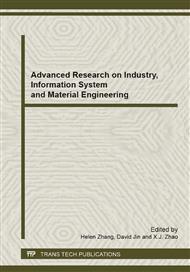[1]
J.W. Raich, C.S. Potter, Global patterns of carbon-dioxide emissions from soils. Glob. Biogeochem. Cycles, 9 (1995) 23-36.
DOI: 10.1029/94gb02723
Google Scholar
[2]
R.T. Conant, R.A. Drijber, M.L. Haddix, W.J. Parton, E.A. Paul, A.F. Plante, J. Six, J.M. Steinweg, Sensitivity of organic matter decomposition to warming varies with its quality. Glob. Change Biol. 14 (2008) 868-877.
DOI: 10.1111/j.1365-2486.2008.01541.x
Google Scholar
[3]
E.A. Davidson, I.A. Janssens, Temperature sensitivity of soil carbon decomposition and feedbacks to climate change. Nature 440 (2006) 165-173.
DOI: 10.1038/nature04514
Google Scholar
[4]
C.M. Fang, P. Smith, J.B. Moncrieff, J.U. Smith, Similar response of labile and resistant soil organic matter pools to changes in temperature. Nature 433 (2005) 57-59.
DOI: 10.1038/nature03138
Google Scholar
[5]
N. Fierer, B.P. Colman, J.P. Schimel, R.B. Jackson, Predicting the temperature dependence of microbial respiration in soil: A continental-scale analysis. Glob. Biogeochem. Cycles 20 (2006), 10.
DOI: 10.1029/2005gb002644
Google Scholar
[6]
J.A.M. Wetterstedt, T. Persson, G.I. Agren, Temperature sensitivity and substrate quality in soil organic matter decomposition: results of an incubation study with three substrates. Glob. Change Biol. 16 (2010), 1806-1819.
DOI: 10.1111/j.1365-2486.2009.02112.x
Google Scholar
[7]
M.A. Bradford, C.A. Davies, S.D. Frey, T.R. Maddox, J.M. Melillo, J.E. Mohan, J.F. Reynolds, K.K. Treseder, M.D. Wallenstein, Thermal adaptation of soil microbial respiration to elevated temperature. Ecol. Lett. 11 (2008) 1316-1327.
DOI: 10.1111/j.1461-0248.2008.01251.x
Google Scholar
[8]
M.A. Bradford, B.W. Watts, C.A. Davies, Thermal adaptation of heterotrophic soil respiration in laboratory microcosms. Glob. Change Biol. 16 (2010) 1576-1588.
DOI: 10.1111/j.1365-2486.2009.02040.x
Google Scholar
[9]
I.P. Hartley, D.W. Hopkins, M.H. Garnett, M. Sommerkorn, P.A. Wookey, Soil microbial respiration in arctic soil does not acclimate to temperature. Ecol. Lett. 11 (2008), 1092-1100.
DOI: 10.1111/j.1461-0248.2008.01223.x
Google Scholar
[10]
R. Hakkenberg, G. Churkina, M. Rodeghiero, A. Borner, A. Steinhof, A. Cescatti, Temperature sensitivity of the turnover times of soil organic matter in forests. Ecol. Appl. 18 (2008) 119-131.
DOI: 10.1890/06-1034.1
Google Scholar
[11]
M.U.F. Kirschbaum, The temperature dependence of organic-matter decomposition - still a topic of debate. Soil Biol. Biochem. 38 (2006) 2510-2518.
DOI: 10.1016/j.soilbio.2006.01.030
Google Scholar
[12]
J.M. Melillo, P.A. Steudler, J.D. Aber, Soil warming and carbon-cycle feedbacks to the climate system. Science 298 (2002) 2173-2176.
DOI: 10.1126/science.1074153
Google Scholar
[13]
W.X. Cheng, R.A. Virginia,. Measurement of microbial biomass in arctic tundar soils using fumigation extraction and substrate-induced respiration proceduers. Soil Biol. Biochem. 25 (1993) 135-141.
DOI: 10.1016/0038-0717(93)90251-6
Google Scholar
[14]
J.H. van't Hoff,. Lectures on Theoretical and Physical Chemistry. Part 1. Chemical dynamics. Edward Arnold, London, UK, 1898.
Google Scholar
[15]
S. Hamdi, T. Chevallier, A. N Ben, H.M. Ben, T. Gallali, J.L. Chotte, M. Bernoux, Short-term temperature dependence of heterotrophic soil respiration after one-month of pre-incubation at different temperatures. Soil Biol. Biochem. 43 (2011).
DOI: 10.1016/j.soilbio.2010.05.025
Google Scholar
[16]
E.K. Hall, G.A. Singer, M.J. Kainz, J.T. Lennon, Evidence for a temperature acclimation mechanism in bacteria: an empirical test of a membrane-mediated trade-off. Func. Ecol. 24 (2010), 898-908.
DOI: 10.1111/j.1365-2435.2010.01707.x
Google Scholar


